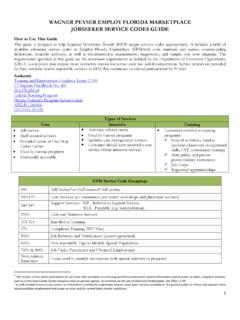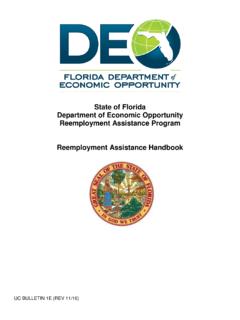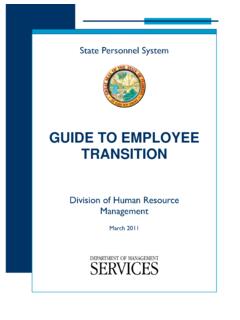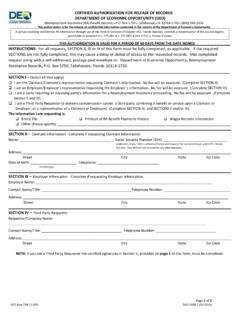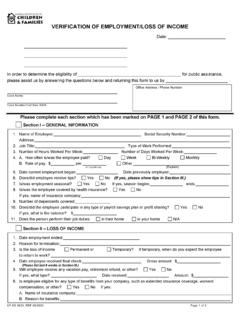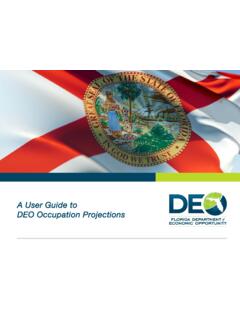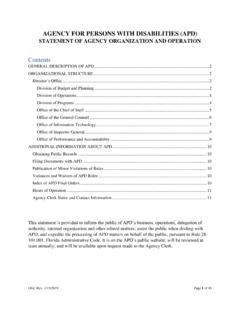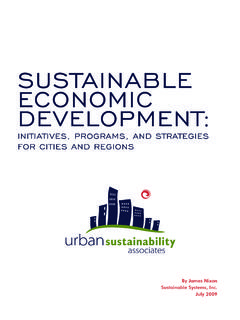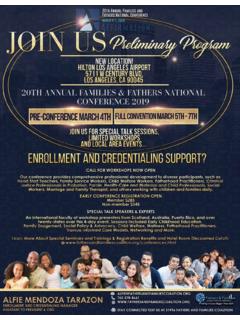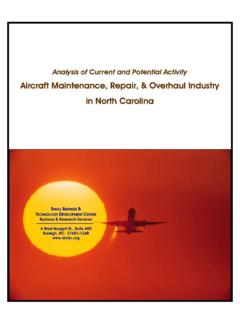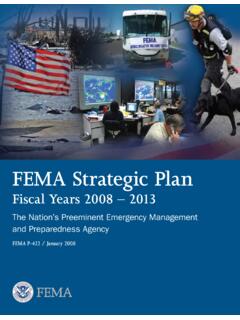Transcription of Temporary Assistance for Needy Families (TANF) Welfare ...
1 1 | P a g e Temporary Assistance for Needy Families (TANF) Welfare Transition (WT) Program Automation The Welfare Transition (WT) program, operated by florida s 24 Regional workforce Boards (RWBs), requires individuals receiving TANF Temporary Cash Assistance (TCA) payments to participate in work activities and move toward economic self-sufficiency. The program serves three major groups: Applicants - individuals who must register for work in order to be eligible for TCA. Mandatory Participants individuals who receive TCA are required to participate Transitional Participants former TCA recipients who are working but need additional Assistance In light of recent TANF cuts, the Regional workforce Boards (RWBs) offered suggestions on how the Department of Economic Opportunity (DEO) could assist in decreasing case management loads and still provide effective, quality services.
2 One of the suggestions was to automate the WT work registration process. In addition, the DEO is automating the Notification of Initial Engagement Requirements. Work Registration is required as a condition of eligibility for TCA as established in s. (1), florida Statute which reads An applicant must meet eligibility requirements of this section before receiving services or Temporary cash Assistance under this chapter, except that an applicant will be required to register for work and engage in work activities in accordance with s.
3 , as designated by the Regional workforce Board and may receive childcare services and support services in conjunction with such requirements. Each RWB has the flexibility to define local work registration requirements and processes; however, the following two major elements are included in every region: 1. Orientation or Program Overview; and 2. Intake/Screening for: a. Domestic Violence b. Medical limitations c. Substance Abuse and Mental Health d. Up-front Diversion RWBs have the option to require other activities in addition to the above as part of their local work registration process.
4 Current Work Registration Process Customers apply for TCA through DCF s ACCESS system. Once an application is made, DCF interviews the applicant and screens each family for benefits as well as their work participation requirements. If during the interview DCF determines the applicant is required to register for work with the local RWB, they will provide the applicant with the career center s location and instruct them to contact the career center for work registration requirements. Once the applicant contacts the region for 2 | P a g e work registration, they may encounter a number of different processes, depending on the area.
5 The customer may complete orientation in a number of ways: 1. Orientation/Program Overview Orientation may be provided in a number of ways. a. Group setting - applicants are given specific dates and times each week to attend established WT informational sessions. Customers are provided information about the program as well as local services. b. Online applicants are given a link to access a presentation about the program and local services. c. One-on-one applicants with extenuating circumstances and cannot attend a group orientation in areas that do not offer an online option may attend a 1:1 session and receive information about the program and local services.
6 Applicants are usually notified of their program Opportunities and Obligations (O & O) during the program overview portion of the process. They sign a paper copy of the form acknowledging that they have read and understand the O & O, which is retained in the case file. 2. Intake/Screening An Intake/Screening form may be delivered in many ways locally. Some regions may require that applicants complete this form while they are attending an orientation session, may be asked to return to complete the screening after orientation or may complete an intake using a regionally developed online system.
7 Automated Work Registration Customers will continue to apply for TCA through DCF s ACCESS system. Once an application is made, DCF interviews the applicant and screens each family for benefits as well as their work participation requirements. If during the interview DCF determines the applicant is required to register for work with the local RWB, they will provide the applicant with instructions on how to access the One Stop Service Tracking (OSST) system if they have access to a computer or provide them with information on the nearest one-stop career center.
8 The Automated Work Registration will allow an applicant to log into OSST and complete work registration requirements online. The following steps/functions have been automated: The Notification of program Opportunities and Obligations (O & O) is currently provided to applicants via a paper form. The automated work registration system will allow the applicant to review an on-line version of form that describes the opportunities available to them and program expectations. The customer then will have to make the decision to either proceed with the work registration process or decline to complete the work registration process.
9 If the customer declines to complete Work Registration, DEO will hold on to the record for 10 days and inform the applicant that they may come back during that time if they change their minds. If the applicant fails to work register during the designated time, a record indicating that the customer Declined will be automatically reported to DCF. Once this is received, DCF will move forward with a decision on the applicant s case. If the customer accepts the O & O, they will move forward to the Orientation or Program Overview which will provide details about program requirements.
10 1. The Orientation/Program Overview will provide the customer with more information about the WT program. Regional workforce Boards can either use the generic general orientation prepared by DEO which will contain general program information and requirements, or upload their own 3 | P a g e locally developed customized program overview. After completing the orientation, the customer will be required to complete an on-line screening. 2. The Intake/Screening or Needs Assessment replaces the local intake/screening and will include a screening of the needs and/or barriers that the applicant may need help resolving in order to participate in the program or find employment.

